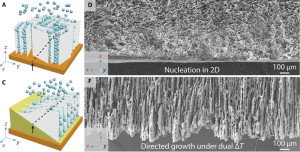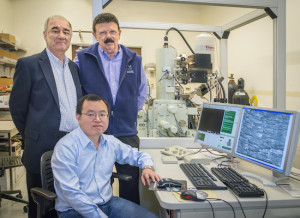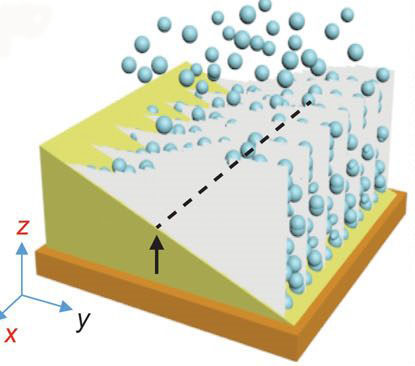
SEM images of xz cross-sections perpendicular to the cold finger show that in conventional freeze-casting (A&D), nucleation produces a disordered layer of ceramic particles. Under bidirectional freeze-casting (C&F), with dual temperature gradients, ice crystals grow both vertically and horizontally into a well-aligned lamellar structure.
It has often been said that nature is history’s greatest innovator and if that is true then scientists with the U.S. Department of Energy (DOE)’s Lawrence Berkeley National Laboratory (Berkeley Lab) are learning from the best. Berkeley Lab researchers have developed a freeze-casting technique that enables them to design and create strong, tough and lightweight materials comparable to bones, teeth, shells and wood.
“Our bidirectional freeze-casting technique could provide an effective way of manufacturing novel structural materials, in particular advanced materials such as composites, where a high level of control over the structure is required,” says Robert Ritchie, an internationally recognized authority on the mechanical behavior of materials with Berkeley Lab’s Materials Sciences Division who led this study along with Antoni Tomsia, who is also with Berkeley Lab’s Materials Sciences Division. “We were inspired by the sophisticated hierarchical architectures ranging from the nano/microscopic to macroscopic scales in certain natural materials that result in outstanding properties despite being porous and made from weak constituents.”
Using their bidirectional freezing technique, the Berkeley researchers were able to successfully induce ceramic particles to assemble into scaffolds with centimeter-scale aligned, porous lamellar (alternating layered) structures, similar to that of nacre (mother-of-pearl). This ordered hierarchical structure was achieved by covering a laboratory “cold finger” with a polydimethylsiloxane wedge that featured different slopes. The result was controlled nucleation and growth of ice crystals during the freezing process under dual temperature gradients.

Tony Tomsia (left), Hao Bai (seated) and Rob Ritchie led the development of a bidirectional freezing technique that
induces ceramic particles to assemble into scaffolds with centimeter-scale aligned, porous lamellar structures. (Photo by Roy Kaltschmidt)
Ritchie, who holds the H. T. and Jessie Chua Distinguished Professor of Engineering chair at the University of California (UC) Berkeley, is one of two corresponding authors of a paper in Science Advances that describes this study in detail. The paper is titled “Bioinspired large-scale aligned porous materials assembled with dual temperature gradients.” Hao Bai, also with Berkeley Lab’s Materials Sciences Division, is both the lead and the other corresponding author. Additional authors are Yuan Chen and Benjamin Delattre.
Nature, despite working from a limited selection of components and at ambient temperature, has over the past few billion years learned to craft a wide range of incredibly diverse materials with astonishingly elegant and complex architectures. These materials are often strong, tough and lightweight – properties that tend to be mutually exclusive.
“The incredible ability of nature to combine the desirable properties of components into a material that performs significantly better than the sum of its parts has served as a source of inspiration for every materials designer,” Ritchie says. “Porous ceramic structures, in particular, are desirable for a wide range of applications, such as supports for catalysis, scaffolds for tissue engineering, foams and fuel cell electrodes, filters for water purification, just to name a few.”
Humans have attempted to emulate nature’s approach to material fabrications through a variety of techniques that have so far proven to be time-consuming, size-limiting and costly. Some of these techniques can also be detrimental to the environment and fail to provide sufficiently precise control over the final structure. Freeze-casting, a technique in which a laboratory cold finger is used to create lamellar ice crystals that serve as a template for making biomimetic scaffolds or composites, can overcome many of these limitations. However, conventional freeze-casting has had one serious limitation of its own that severely hinders the scale-up fabrication of layered structures aimed for larger applications.
“In conventional freeze-casting, the slurry starts freezing under a single temperature gradient, causing the nucleation of ice to occur randomly on the cold finger surface,” Bai says. “As a result, multiple submillimeter scale domains are created in which are formed various ice crystal orientations in the plane perpendicular to the freezing direction.”
To overcome this limitation, Ritchie, Bai and their colleagues used polydimethylsiloxane (PDMS) wedges with different slopes to isolate the cold finger from the slurry. On cooling, the bottom end of the wedge has a lower temperature than the top end. By proper adjustment of the cooling rate, two temperature gradients – vertical and horizontal – are generated at the same time. Under these conditions, the slurry starts freezing in a gradient manner from the bottom to the top of the wedge with ice crystals nucleating only at the bottom end of the wedge, and growing preferentially in two directions: vertically away from the cold finger and horizontally along the PDMS wedge. The result, after sublimating and sintering, is a centimeter-scale monodomain lamellar structure.
The Berkeley researchers successfully tested their bidirectional freezing technique on particles of hydroxyapatite, a naturally occurring mineral of calcium and the main component of tooth enamel and bone mineral, as a proof of concept, but they say it should be applicable to many other materials system, including ceramic particles or platelets.
“Apart from the slope angle and the cooling rate, many other parameters, such as solid loading or various additive compounds, are currently being investigated in our laboratory for their effect on bidirectional freezing technique,” Bai says.
Ritchie cautions though that even under the most favorable of circumstances, it can take decades for the applications of new structural materials to be fully realized.
“Our motivation in developing our bidirectional freeze-casting technique has been to make lightweight structural materials, with potential applications in transportation and power generation industries,” he says. “However, the most likely applications in the shorter term for the materials that can be made with this technique will be in medical implants, such as bone/orthopedic implants. Our materials are stiff, strong and tough and can closely match the mechanical properties of bone while specifically preventing the stress-shielding that can cause bone to atrophy.”
This research was primarily supported by the DOE Office of Science.
Additional Information
For more about the research of Robert Ritchie go here
# # #
Lawrence Berkeley National Laboratory addresses the world’s most urgent scientific challenges by advancing sustainable energy, protecting human health, creating new materials, and revealing the origin and fate of the universe. Founded in 1931, Berkeley Lab’s scientific expertise has been recognized with 13 Nobel prizes. The University of California manages Berkeley Lab for the U.S. Department of Energy’s Office of Science. For more, visit www.lbl.gov.
DOE’s Office of Science is the single largest supporter of basic research in the physical sciences in the United States, and is working to address some of the most pressing challenges of our time. For more information, please visit the Office of Science website at science.energy.gov/.
